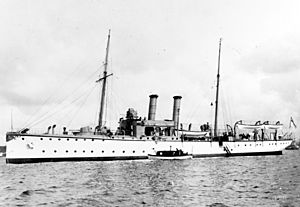Gunboat diplomacy facts for kids
In international politics, the term gunboat diplomacy refers to the pursuit of foreign policy objectives with the aid of conspicuous displays of naval power, implying or constituting a direct threat of warfare should terms not be agreeable to the superior force.
Contents
Etymology
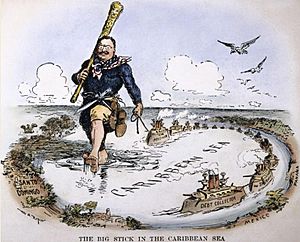
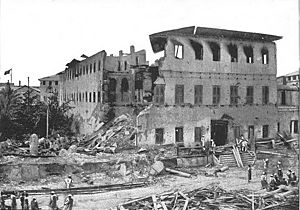
The term comes from the nineteenth-century period of imperialism, when Western powers – in Europe and the United States – would intimidate other, less powerful states into granting concessions through a demonstration of their superior military capabilities, usually represented by their naval assets. A country negotiating with a Western power would notice that a warship or fleet of ships had appeared off its coast. The mere sight of such power almost always had a considerable effect, and it was rarely necessary for such boats to use other measures, such as demonstrations of firepower.
A notable example of gunboat diplomacy was the Don Pacifico affair in 1850, in which the British Foreign Secretary Lord Palmerston dispatched a squadron of the Royal Navy to blockade the Greek port of Piraeus in retaliation for the assault of a British subject, David Pacifico, in Athens, and the subsequent failure of the government of King Otto to compensate the Gibraltar-born (and therefore British) Pacifico.
The effectiveness of such simple demonstrations of a nation's projection of force capabilities meant that nations with naval power and command of the sea could establish military bases (for example, Diego Garcia) and arrange economically advantageous relationships around the world. Aside from military conquest, gunboat diplomacy was the dominant way to establish new trade partners, colonial outposts, and expansion of empire.
Those lacking the resources and technological advancements of Western empires found that their own peaceable relationships were readily dismantled in the face of such pressures, and they therefore came to depend on the imperialist nations for access to raw materials and overseas markets.
Diplomat and naval thinker James Cable spelled out the nature of gunboat diplomacy in a series of works published between 1971 and 1993. In these, he defined the phenomenon as "the use or threat of limited naval force, otherwise than as an act of war, in order to secure advantage or to avert loss, either in the furtherance of an international dispute or else against foreign nationals within the territory or the jurisdiction of their own state." He further broke down the concept into four key areas:
- Definitive Force: the use of gunboat diplomacy to create or remove a fait accompli.
- Purposeful Force: application of naval force to change the policy or character of the target government or group.
- Catalytic Force: a mechanism designed to buy a breathing space or present policy makers with an increased range of options.
- Expressive Force: use of navies to send a political message. This aspect of gunboat diplomacy is undervalued and almost dismissed by Cable.
Gunboat diplomacy comes in contrast to the views held prior to the 18th century influenced by Hugo Grotius, De Jure Belli ac Pacis, in which he circumscribed the right to resort to force with what he described as "temperamenta".
Gunboat diplomacy is distinct from "defence diplomacy", which is understood to be the peaceful application of resources from across the spectrum of defence, to achieve positive outcomes in the development of bilateral and multilateral relationships. "Military diplomacy" is a sub-set of this, tending to refer only to the role of military attachés and their associated activity. Defence diplomacy does not include military operations, but subsumes such other defence activity as international personnel exchanges, ship and aircraft visits, high-level engagement (e.g., ministers and senior defence personnel), training and exercises, security-sector reform, and bilateral military talks.
Modern contexts
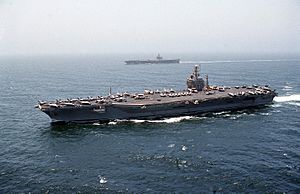

Gunboat diplomacy is considered a form of hegemony. As the United States became a military power in the first decade of the 20th century, the Rooseveltian version of gunboat diplomacy, Big Stick Diplomacy, was partially superseded by dollar diplomacy: replacing the big stick with the "juicy carrot" of American private investment. However, during Woodrow Wilson's presidency, conventional gunboat diplomacy did occur, most notably in the case of the U.S. Army's occupation of Veracruz in 1914, during the Mexican Revolution.
Gunboat diplomacy in the post-Cold War world is still largely based on naval forces, owing to the U.S. Navy's overwhelming sea power. U.S. administrations have frequently changed the disposition of their major naval fleets to influence opinion in foreign capitals. More urgent diplomatic points were made by the Clinton administration in the Yugoslav wars of the 1990s (in alliance with the Blair administration) and elsewhere, using sea-launched Tomahawk missiles, and E-3 AWACS airborne surveillance aircraft in a more passive display of military presence. Henry Kissinger, during his tenure as United States Secretary of State, summed up the concept as thus: "An aircraft carrier is 100,000 tons of diplomacy."
Notable examples
18th century
19th century
- Second Barbary War (1815)
- Pastry War (1838–39)
- Don Pacifico Incident (1850)
- Second Anglo-Burmese War (1852)
- Opening of Japan by United States Navy Commodore Matthew C. Perry and his Black Ships (1853–54)
- Paraguay expedition (1858–9)
- Shimonoseki Campaign (1863–1864)
- Christie Affair (1861–1865)
- Shinmiyangyo in Korea (1871)
- Ganghwa Island incident (1875)
- Môle Saint-Nicolas affair (1889–1891)
- Baltimore crisis (1891)
- Franco-Siamese War of 1893
- Anglo-Zanzibar War (1896)
- Luders Affair (1897)
- Yangtze River Patrol (1850s–1930s)
- Overthrow of the Kingdom of Hawaii (1893)
20th century
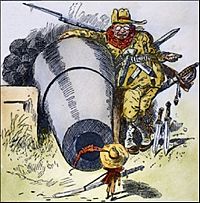
- Venezuela Crisis of 1902–1903
- Panama separation from Colombia
- Great White Fleet (1907)
- Agadir Crisis (1911)
- Occupation of Veracruz (1914)
- Danzig crisis (1932)
- First Taiwan Strait Crisis (1954–55)
- Second Taiwan Strait Crisis (1958)
- Operation Vantage (1961)
- Liberation of East Pakistan (1971)
- Third Taiwan Strait Crisis (1995–96)
21st century
- Spratly Islands dispute
See also
 In Spanish: Diplomacia de cañonero para niños
In Spanish: Diplomacia de cañonero para niños


